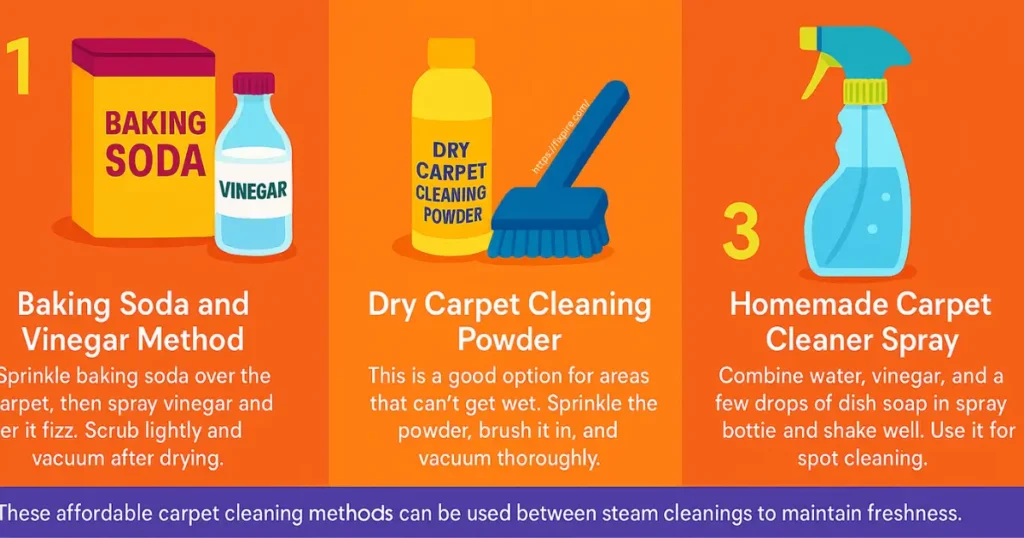If you’re tired of expensive carpet cleaning services draining your wallet, learning how to save money with DIY carpet steam cleaning might be one of the smartest decisions you’ll make. By using affordable tools and smart techniques, you can maintain spotless carpets and keep your home fresh—all without spending a fortune. This guide dives deep into everything you need to know, from choosing the right tools to executing each step like a pro.

Why DIY Carpet Steam Cleaning Is the Smart Choice
Carpets trap dirt, allergens, and bacteria over time. Professional cleaning can be costly, especially when done regularly. But DIY carpet steam cleaning at home allows you to control both your budget and cleaning schedule. With just a few simple tools, you can refresh your carpet and extend its life.
Moreover, DIY cleaning gives you full control over the chemicals used, ensuring a safer environment for children and pets. And let’s be honest—it’s incredibly satisfying to clean something yourself and see visible results.
Tools You Need for DIY Carpet Steam Cleaning at Home
Before you begin, gather these budget-friendly essentials:
- Steam Cleaner – Buy or rent one. Handheld models are affordable and great for small areas.
- Distilled Water – Reduces residue and scale buildup in the machine.
- White Vinegar or Mild Detergent – Natural and effective cleaning agents.
- Soft-Bristled Brush – Helps loosen tough stains.
- Microfiber Towels or Dry Cloths – For blotting excess moisture.
Optional but helpful:
- Baking Soda – Deodorizes carpets before steaming.
- Essential Oils – Add a few drops for fragrance.
These simple items make it easy to perform home carpet steam cleaning tips effectively.
How to Steam Clean Carpet Yourself Step-by-Step
If you’re ready to refresh your carpets without hiring a professional, you’ll be happy to know that steam cleaning your carpet yourself is not only possible but surprisingly simple. With just a few tools and a little time, you can restore your carpet’s look and feel while saving a significant amount of money. Follow this detailed, beginner-friendly step-by-step guide to get amazing results with minimal effort.
Step 1: Vacuum the Carpet Thoroughly
Before anything else, start with a deep and thorough vacuuming session. This is a step many people underestimate, but it’s one of the most important. Vacuuming helps remove surface-level dirt, dust, pet hair, food crumbs, and any loose debris sitting on top of your carpet fibers. If this step is skipped, the steam cleaner will end up pushing the dirt deeper into the fibers instead of removing it.
Use a vacuum cleaner with strong suction and a beater bar if possible, especially for high-pile carpets. Go over each section multiple times and use the hose attachment to get into corners, edges, and along the baseboards.
Step 2: Pre-Treat Any Stains
After vacuuming, check for stains like coffee spills, pet accidents, or grease marks. These areas will need extra attention before steaming. To treat them, mix a simple solution of equal parts white vinegar and warm water in a spray bottle. Spray the solution generously on the stains and let it sit for about 10 to 15 minutes. For stubborn spots, you can lightly scrub with a soft-bristled brush.
Alternatively, you can use a mild carpet-safe detergent if vinegar isn’t strong enough. Just make sure whatever solution you choose is safe for your carpet type and doesn’t contain harsh chemicals that might cause damage or discoloration.
Step 3: Fill Your Steam Cleaner Properly
Next, prepare your steam cleaner according to the manufacturer’s instructions. Most machines require distilled water to avoid mineral buildup, especially if you live in a hard water area. Some steam cleaners also allow the addition of a cleaning solution. In this case, you can add a small amount of white vinegar or a few drops of a carpet-safe detergent. Be cautious—not to overfill or use too much product.
Using distilled water not only protects your machine but also helps your carpet dry faster and prevents sticky residue from forming, which can attract more dirt over time.
Step 4: Start Steaming in Small Sections
Begin steaming from the farthest corner of the room, working your way toward the exit. This helps prevent walking over freshly cleaned, damp areas. Move the steam cleaner slowly in straight lines, allowing the steam and suction to work properly. Don’t rush—let the steam penetrate and lift the dirt before moving forward.
Work in small, manageable sections, overlapping slightly to ensure full coverage. Avoid going over the same spot multiple times in one go, as this can over-saturate the carpet, making it harder to dry and possibly causing mildew or mold.
Step 5: Blot Excess Moisture and Let It Dry
After steaming the carpet, you may notice some areas are slightly damp. This is normal. Use microfiber towels or clean, dry cloths to blot the moisture. Press gently but firmly to soak up as much water as possible, especially in spots where extra solution was used or the machine passed more than once.
To help the carpet dry faster, open windows, turn on ceiling or standing fans, or even run a dehumidifier in the room. Avoid walking on the carpet until it’s completely dry, which typically takes 4 to 8 hours, depending on ventilation and humidity levels.
By following these steps carefully, you’ll achieve a deep-cleaned, fresh-smelling carpet without calling in the pros. Not only does this save money, but it also allows you to maintain your carpets more regularly and safely. The satisfaction of doing it yourself? That’s just a bonus!
How to Save Money with DIY Carpet Steam Cleaning
Let’s break down just how much you save.
Professional carpet cleaning costs around $150–$300 per room, depending on the company and carpet size. In contrast, renting a steam cleaner costs $30–$50 per day, and buying one for home use ranges from $70 to $150.
Cleaning your carpet 2–3 times a year means you save hundreds annually. Plus, you can reuse tools and cleaning agents for years, making this a long-term win.
Save Money with DIY Carpet Cleaning: The Math
Let’s say you clean three rooms:
- Professional service: 3 x $200 = $600 annually
- DIY method: Equipment rental + supplies = ~$80 annually
Annual savings: Over $500!
The more frequently you clean, the more benefits you’ll gain. This makes DIY carpet steam cleaning at home one of the best ways to keep your home fresh on a budget.
Affordable Carpet Cleaning Methods That Work

Apart from steam cleaning, you can mix up your approach using these budget-friendly alternatives:
1. Baking Soda and Vinegar Method
- Sprinkle baking soda over the carpet, then spray vinegar and let it fizz. Scrub lightly and vacuum after drying.
2. Dry Carpet Cleaning Powder
- This is a good option for areas that can’t get wet. Sprinkle the powder, brush it in, and vacuum thoroughly.
3. Homemade Carpet Cleaner Spray
- Combine water, vinegar, and a few drops of dish soap in a spray bottle and shake well. Use it for spot cleaning.
These affordable carpet cleaning methods can be used between steam cleanings to maintain freshness.
Home Carpet Steam Cleaning Tips for Better Results
Make your efforts more effective with these home carpet steam cleaning tips:
- Always vacuum before steaming.
- Test cleaning agents on a small patch first.
- Don’t over-soak the carpet—this can lead to mildew.
- Let carpets dry completely before walking on them.
- Clean in one direction for a more uniform look.
- Add a few drops of lavender or lemon essential oil for freshness.
Safety First: Keep It Clean, Keep It Safe
DIY cleaning also helps avoid harsh chemicals. Always read labels, ventilate the room well, and wear gloves if you have sensitive skin. This approach not only saves money but protects your family and the environment.
When to DIY and When to Call Professionals
DIY is ideal for:
- Light to moderate dirt
- Routine cleaning
- Spot stain removal
Call the pros if:
- There’s water damage or mold
- The carpet has deep-set stains
- You haven’t cleaned it in years
Mixing both methods throughout the year can keep your carpet in the best condition.
Final Thoughts: Clean Smarter, Not Harder
Learning how to save money with DIY carpet steam cleaning using simple tools is not just practical—it’s empowering. You take control of your home’s cleanliness while saving hundreds over time. With the right approach, anyone can achieve professional-level results without breaking the bank.
Make carpet cleaning part of your seasonal home care routine and you’ll enjoy a cleaner, healthier living space year-round.








